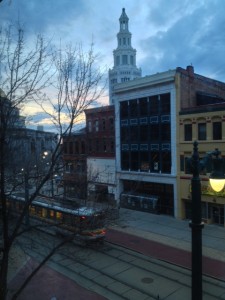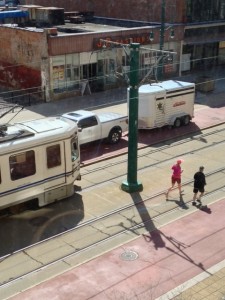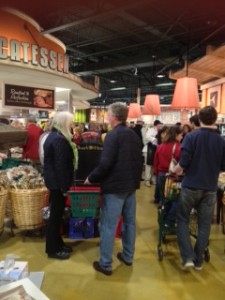
The view outside my window in downtown Buffalo shows a less than vibrant historic district and a little used light rail. Rumors abide about changes.
I want to start out by saying that I grew up in the suburbs and I had a fabulous childhood. And yet since I left home I have only lived in cities and now apparently I am among the new guard who are moving downtown. According to Jim Russell who writes on the Sustainable Cities Collective, “today the urban core is the new suburb.” My parents are the classic examples of those who fled from the decaying inner city in the 1960s to the suburbs, when leaving the city and moving to a first-ring suburb, Tonawanda and then ultimately to an exurb like East Amherst, was aspirational. And both my sister and I are grateful we grew up where we did. We got outstanding educations, we had a house and a yard, had our own bedrooms and played with our friends in the street. But like every thing these days, there are lines in the sand being drawn between the suburbs and the city – either one is good and the other isn’t or you can’t have your cake and eat it too. If you stand up for the suburb you’re anti-climate change and you’re in Joel Koktin’s camp. If you prefer the city, then you’re a Richard Florida fan. But what if you can see the pros and cons of both?
Two Years and Counting
Well, if you can defend both the suburb and the city, then you’re probably like me – Baby Boomer who grew up in the suburbs but rebelled from my parents and moved straight away to the biggest city I could find – New York City!! But I never totally gave up on the suburb.
Today is the two-year anniversary of BAC/Architecture + Planning. As I sit in the grants review panel of a foundation in Philadelphia I am admiring and enjoying the vibrant downtown core of a revived city. And pondering the not so vibrant core of the downtown city I am living in. There are hints downtown Buffalo could be changing. Rumors about a grocery store. Changes to the light rail. And one day of sun and 72 degrees was all that was needed for the number of pedestrians in front of my building to jump a hundredfold. Skateboarders, joggers, people with strollers. All it took was sun and the chance to shed those down coats to knock me and everyone in Buffalo out of our winter malaise! Happy anniversary to me!

Looking out my window the other way, runners are starting to populate the view now that we can shed our down coats.
But here’s the current major problem with a downtown like Buffalo, it’s just not walkable yet. Oh there are pockets of walkable neighborhoods of course in the city like the Elmwood Village, but not downtown. Well let me clarify, I can walk, there’s just not a lot to walk to. There are buildings being rehabbed by entrepreneurial developers for residential like mine. There is a boutique hotel here and there. And the occasional great restaurant here and there. But there is little to connect them. A lot of places are closed on weekends. There is no grocery store. And while I love my loft which is the most phenomenal place I’ve lived in, and the world-class architecture on every corner, as I spend 4 days in Philadelphia, I remember what I’m missing, what I had for the past 25 years in NYC, Seattle and Washington.
Take my walk around my hotel yesterday in the Rittenhouse Square neighborhood of Philadelphia – in a two-block radius I counted 10 nail salons, innumerable restaurants, a tea shop, shoe stores, clothing stores, a small grocery store, Trader Joe’s, countless pharmacies and banks. And every one was filled with people. There were no vacant buildings. Yes, I know, Philadelphia has a population of 1.5 million. But when I first started coming here regularly 20 years ago, Philadelphia’s downtown wasn’t so much different than Buffalo’s. But is the downtown core of Philadelphia blossoming while the outer neighborhoods are still decaying? Why is it so hard to have it all? Is the creative class moving to places like Buffalo?
Different Choices for Different People
In cities like Buffalo across the country, people don’t have the density choice of a Philadelphia, Chicago, Seattle or NYC. There are pockets of terrific neighborhoods like the Elmwood Village but not everyone can or wants to live there. For example I wanted loft-like space where I could have my office and home. For others, the choice is one of good public schools (and not every child can get into the charter schools), a little piece of land to call one’s own or even something new. Even if I were to move back to Manhattan, my dream place wouldn’t be on the 100th floor of a skyscraper, it would be my own 3-story townhouse on the Upper East Side. I like to look at those skyscrapers, even visit them, but live there? No way. Years ago when the twin towers were still here, my cousins from Sicily were visiting and I had a good friend who worked in the Architecture department of the World Trade Center. We got Chinese takeout and went to an empty office on the 102nd floor of the North Tower and sat at the window eating. We were above the clouds. It’s one of the most memorable experiences of our lives, but would I want to do that for every meal? Once again, no way!
Why The Suburbs Continue To Grow
According to Robert Krulwich who blogs on science for NPR, even if we all agreed to live in one megacity like Hong Kong, that wouldn’t mean that we would have less impact on the planet. Unless we could all agree to live with one pair of shoes and one bike, earth has a big human problem. I end presentations sometimes with “The Greenest Planet is one without us in it.”

With no grocery shops downtown and nothing I like in the city, I find myself driving 20 miles to the suburbs to a new Whole Foods-like store called Orchard Fresh.
Once again, according to Jim Russell, in the last decade, the populations of cities like Charlotte, Houston, Atlanta, and Nashville grew by 20 percent or more, at least four times as rapidly as New York, Los Angeles, San Francisco, or Chicago. This trend toward less dense, more affordable cities is as evident in the most recent census numbers of the past decade. Cities like Charlotte, Houston, Atlanta, Nashville and even Austin have less dense cores and expanding suburban rings. We like our houses and yards. And for me, someone who finds myself an urban pioneer again, I go to the suburbs to shop. It’s easier and I can get everything I want. The traffic gets worse and worse. I complain about sprawl but I contribute to it by supporting the commerce. But what other option do I have? I have no shopping options downtown and I find most of the other city options for food and necessities mediocre at best. I can find great shops for clothes, reused furniture or jewelry in the city, but not everything else.

Spring arrived late In Buffalo this year, which makes my blossoming orchid framing downtown’s mounted police even sweeter.
Which brings me once again to my plea for balance and gray. The answer is not going to be a world takeover by either the urbanites or the suburbanites. We need to figure out how to make both as efficient as possible. They’re here. The damage is done. Now let’s figure it out together.
I’m reading Sheryl Sandberg’s book “Lean In” and while her use of that term is more nuanced than is being presented, it is lining women up on different sides – “lean in” and act more like a man and show great ambition or “lean back” and embrace mediocrity.
So after a lifetime of sports injuries I can rarely lean in or lean back. Just standing up straight like Real Simple’s editor Kristin Van Ogtrop is an accomplishment. My hope for year three of my business is that downtown Buffalo will get a little more dense like NYC OR provide a little more commerce like East Amherst so I wouldn’t have to lean OUT my front window quite so far to see pedestrians or a good grocery store.
And if you’d like to “subscribe” or follow my blog, True Green Cities, please sign up through the “Subscribe” button at the bottom left of this page. You’ll receive a daily recap when new blogs are posted. Or Sign up for the Feed.

